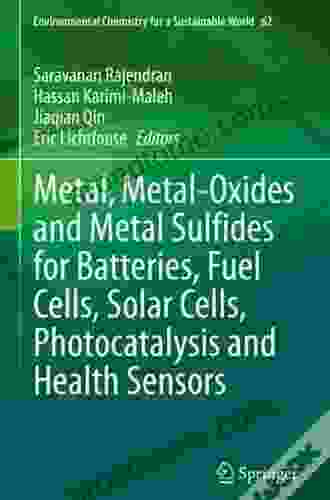Metal Metal Oxides And Metal Sulfides For Batteries Fuel Cells Solar Cells

Metal metal oxides and metal sulfides are a class of materials that have been extensively studied for their potential applications in batteries, fuel cells, and solar cells. These materials offer a number of advantages over traditional materials, such as high energy density, long cycle life, and low cost.
5 out of 5
| Language | : | English |
| File size | : | 53343 KB |
| Text-to-Speech | : | Enabled |
| Enhanced typesetting | : | Enabled |
| Print length | : | 592 pages |
| Screen Reader | : | Supported |
This book provides a comprehensive overview of the latest developments in the field of metal metal oxides and metal sulfides for batteries, fuel cells, and solar cells. The book covers a wide range of topics, including the synthesis, characterization, and electrochemical performance of these materials.
Synthesis
Metal metal oxides and metal sulfides can be synthesized using a variety of methods, including chemical vapor deposition, sol-gel processing, and hydrothermal synthesis. The choice of synthesis method depends on the desired properties of the material.
Chemical vapor deposition is a process in which a metal-organic precursor is vaporized and then deposited on a substrate. This method can be used to produce thin films of metal metal oxides and metal sulfides with controlled composition and morphology.
Sol-gel processing is a process in which a metal-organic precursor is dissolved in a solvent and then gelled. The gel is then heated to form a ceramic material. This method can be used to produce powders and thin films of metal metal oxides and metal sulfides with high purity and homogeneity.
Hydrothermal synthesis is a process in which a metal-organic precursor is dissolved in water and then heated under pressure. This method can be used to produce nanocrystals and nanoparticles of metal metal oxides and metal sulfides with controlled size and shape.
Characterization
The properties of metal metal oxides and metal sulfides can be characterized using a variety of techniques, including X-ray diffraction, electron microscopy, and electrochemical impedance spectroscopy.
X-ray diffraction is a technique that can be used to determine the crystal structure of a material. This information can be used to identify the phase of the material and to determine the size and shape of the crystallites.
Electron microscopy is a technique that can be used to visualize the surface morphology of a material. This information can be used to determine the size and shape of the particles and to identify any defects or impurities.
Electrochemical impedance spectroscopy is a technique that can be used to measure the electrical properties of a material. This information can be used to determine the conductivity, capacitance, and inductance of the material.
Electrochemical Performance
The electrochemical performance of metal metal oxides and metal sulfides depends on a number of factors, including the composition, structure, and morphology of the material. The composition of the material determines the redox activity of the material, while the structure and morphology of the material determine the surface area and porosity of the material.
The redox activity of a material is a medida of its ability to undergo electrochemical reactions. The higher the redox activity of a material, the more efficient it will be as a battery or fuel cell electrode.
The surface area of a material is a medida of the amount of surface area that is available for electrochemical reactions. The higher the surface area of a material, the more efficient it will be as a battery or fuel cell electrode.
The porosity of a material is a medida of the amount of void space that is present in the material. The higher the porosity of a material, the more efficient it will be as a battery or fuel cell electrode.
Applications
Metal metal oxides and metal sulfides have a wide range of applications in batteries, fuel cells, and solar cells.
In batteries, metal metal oxides and metal sulfides are used as cathode materials. Cathode materials are responsible for storing the energy in a battery. The higher the redox activity, surface area, and porosity of a cathode material, the more efficient the battery will be.
In fuel cells, metal metal oxides and metal sulfides are used as anode materials. Anode materials are responsible for generating the hydrogen that is used to power the fuel cell. The higher the redox activity, surface area, and porosity of an anode material, the more efficient the fuel cell will be.
In solar cells, metal metal oxides and metal sulfides are used as absorber materials. Absorber materials are responsible for converting light into electricity. The higher the redox activity, surface area, and porosity of an absorber material, the more efficient the solar cell will be.
Metal metal oxides and metal sulfides are a promising class of materials for batteries, fuel cells, and solar cells. These materials offer a number of advantages over traditional materials, such as high energy density, long cycle life, and low cost. This book provides a comprehensive overview of the latest developments in the field of metal metal oxides and metal sulfides for batteries, fuel cells, and solar cells. The book covers a wide range of topics, including the synthesis, characterization, and electrochemical performance of these materials.
5 out of 5
| Language | : | English |
| File size | : | 53343 KB |
| Text-to-Speech | : | Enabled |
| Enhanced typesetting | : | Enabled |
| Print length | : | 592 pages |
| Screen Reader | : | Supported |
Do you want to contribute by writing guest posts on this blog?
Please contact us and send us a resume of previous articles that you have written.
 Book
Book Novel
Novel Page
Page Chapter
Chapter Text
Text Story
Story Genre
Genre Reader
Reader Library
Library Paperback
Paperback E-book
E-book Magazine
Magazine Newspaper
Newspaper Paragraph
Paragraph Sentence
Sentence Bookmark
Bookmark Shelf
Shelf Glossary
Glossary Bibliography
Bibliography Foreword
Foreword Preface
Preface Synopsis
Synopsis Annotation
Annotation Footnote
Footnote Manuscript
Manuscript Scroll
Scroll Codex
Codex Tome
Tome Bestseller
Bestseller Classics
Classics Library card
Library card Narrative
Narrative Biography
Biography Autobiography
Autobiography Memoir
Memoir Reference
Reference Encyclopedia
Encyclopedia Xandria Williams
Xandria Williams William Panek
William Panek Warren Jefferson
Warren Jefferson Scott Barry Kaufman
Scott Barry Kaufman Larry J Kolb
Larry J Kolb Tricia Mccannon
Tricia Mccannon Sophia Love
Sophia Love Stacey Agin Murray
Stacey Agin Murray Sarah Raven
Sarah Raven Steven Hahn
Steven Hahn Uchemadu Nwachukwu
Uchemadu Nwachukwu Shaila Misri
Shaila Misri Stephen Scher
Stephen Scher Susan Joy Paul
Susan Joy Paul Stuart Isacoff
Stuart Isacoff Susan Middleton Elya
Susan Middleton Elya Tammy Nelson
Tammy Nelson Pirta Liljekvist
Pirta Liljekvist Shane Dixon
Shane Dixon Simon Monk
Simon Monk
Light bulbAdvertise smarter! Our strategic ad space ensures maximum exposure. Reserve your spot today!

 Marc FosterTheodore Gray's ABC Elements: Baby Elements - Igniting a Love for Science in...
Marc FosterTheodore Gray's ABC Elements: Baby Elements - Igniting a Love for Science in... Carl WalkerFollow ·2.6k
Carl WalkerFollow ·2.6k Edwin CoxFollow ·6.6k
Edwin CoxFollow ·6.6k Alexandre DumasFollow ·12k
Alexandre DumasFollow ·12k Adrien BlairFollow ·6.6k
Adrien BlairFollow ·6.6k Alex ReedFollow ·4.7k
Alex ReedFollow ·4.7k Dalton FosterFollow ·9.6k
Dalton FosterFollow ·9.6k Pablo NerudaFollow ·2.2k
Pablo NerudaFollow ·2.2k Roland HayesFollow ·6.1k
Roland HayesFollow ·6.1k

 Timothy Ward
Timothy WardSteamy Reverse Harem with MFM Threesome: Our Fae Queen
By [Author...

 Cody Blair
Cody BlairThe Ultimate Guide to Energetic Materials: Detonation and...
Energetic materials are a fascinating and...

 Kenzaburō Ōe
Kenzaburō ŌeProstitution, Modernity, and the Making of the Cuban...
By Emily A....

 Kirk Hayes
Kirk HayesUnveil the Enchanting World of The Rape of the Lock by...
Alexander Pope's epic...

 Ivan Turgenev
Ivan TurgenevTantric Quest: An Encounter With Absolute Love
Embark on a Tantric Quest to...

 Gary Reed
Gary ReedThe Darwin Awards: Evolution in Action
The Darwin Awards are a...
5 out of 5
| Language | : | English |
| File size | : | 53343 KB |
| Text-to-Speech | : | Enabled |
| Enhanced typesetting | : | Enabled |
| Print length | : | 592 pages |
| Screen Reader | : | Supported |










